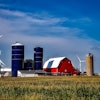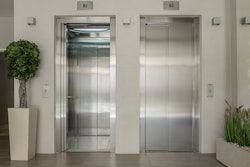As they eyed the line of trucks waiting at the scales, the sole owner and manager of an imaginary Midwest elevator, Dave, says to his son Gary: “It seems like yesterday when country elevators were selling for 10 cents on the dollar — couldn’t hardly give ‘em away.Guess that was six or seven years ago, though.Now it seems like everybody’s expanding, and I read last week about a couple of big companies buying some country elevators and planning to overhaul them. Maybe we need to sit down and evaluate our situation; nobody’s called us about selling.”
This is a great time for agriculture.
Foreign production of coarse grains doesn’t match consumption [see Chart 1], even with production growth in the Former Soviet Union, South America and other countries. Global soybean consumption is soaring as well, and U.S. exports have climbed 15M+ tonnes in a decade — as much as Brazil and Argentina export growth combined! This global demand for crops brings the world to our doorstep. Exports of the three main U.S. crops have climbed 31% in the last decade [see Chart 2], an average 2.6% annually, with domestic consumption rising 29% at the same time.
Total disappearance of 2010 crop corn, soybeans and wheat is forecast at a record 19.1 billion bushels. By 2020, 2.6% annual growth would raise total disappearance to 25 billion bushels.
Even assuming a slower growth pace, U.S. agriculture will face stiff demands. Will Dave be ready?
Obstacles await
Dave and his son Gary face daunting challenges amidst a changing landscape. Dramatic consolidation in the grain business over the last 20 years has left fewer entities handling ever-larger volumes of higher-priced crops. One result is the financing demands have exploded for the remaining firms, in both working capital and credit lines. The flow of investment money into commodities, and the global demand for food and feedstuffs to sustain larger and more affluent populations have contributed to rising prices on top of rising consumption. Handling grain for a few cents per bushel makes no sense in this modern environment where million dollar margin calls are routine and farmers want to sell crops two years ahead. Elevators certainly need to work on margins that reflect today’s risks.
Even though the borrower may appear to be the same business it was years ago. Lenders understandably are getting tougher, requiring more documentation, increased oversight, and greater working capital. Smaller businesses such as Dave and Gary’s elevator can find themselves struggling to meet these sometimes competing demands.
Chart 3 shows an approximation of the value of U.S. corn crops since 1972. The red line shows this was surprisingly flat until 2000, but has tripled since then, to over $50 billion.And that’s just for corn!The dollar values are calculated using the USDA annual weighted average cash price for the crop year, times production. (For 2009 and 2010, a simple average of monthly prices was used; USDA final annual prices are not yet available.)
A second major challenge facing Dave and many others is that much of the country’s agribusiness infrastructure is getting long in the tooth. Most firms have added bins, legs and dryers, but typically around an existing facility. Some elevators have ‘cores’ that may be 50 or more years old, and a lot of bins date back to the CCC days. This infrastructure will require costly repairs or retrofitting in the years ahead, adding to the financing demands for the industry. A lot of firms also have facilities that are now ‘in-town’ and less convenient for their farm customers, putting them at a competitive disadvantage in some cases. It may be more cost-effective for some firms to start over at a new site — a “green field” approach — versus retrofitting and rehabbing. Interest rates are low and this is a good time to make these capital investments.
Around the industry, many elevators not only are adding space, but tackling the issue of what their business really needs for the future. The trigger may be discovering that a land lease cost will rise dramatically if the elevator can’t load unit-train sizes. In one area the lease cost for a single-car loading facility was quoted recently at 16 times the cost if they could load shuttles. This is a direct cost, but the additional cost is the higher per-bushel cost on the actual freight rates for small shippers. Another trigger may be growth of on-farm bins and dryer set-ups in their area. As farms get larger, producers don’t want to wait to unload at harvest, or deal with inefficient operations with poor traffic flow and other ‘disruptions'.
To put that in perspective, one implement company says their smallest combine today is the size of theirlargest, top of the line combine a decade ago. They may have been exaggerating — but perhaps not — and the story clearly shows that farmers value speed and efficiency. And time is a factor: Renovation and expansion won’t happen overnight. Elevator managers report that it takes 6 to 9 months before a new bin can be up once it’s ordered.
From OSHA to EPA, a third challenge is the rising regulatory burden facing these entities. Multiple grain-engulfment deaths, for example, have soundly driven this point home in recent months, fueling growth in safety consultant programs, individual training programs, acquiring safety equipment, and in some cases — capital improvements. Compliance will be costly, but non-compliance may be more so.
The big picture
Dave and Gary are correct to evaluate their business path and formulate a strategic plan, but this can be a daunting undertaking for a small business. The starting place for an owner-operator such as Dave needs to be where they want the business to be in five years. Are they running the business to sell it eventually, or is Gary planning to take over down the road? Major capital investments may not be justified if the objective is to sell within a few years. In that case it may be prudent to focus on smaller, affordable changes and let a future buyer make major changes.
One place where Dave could start is to bring in someone to objectively review his facility and operations. This could be as simple as evaluating the physical location — studying onsite traffic flow for trucks and people, the location of scales and dumps, as well as more complex issues. Dave and Gary may not be able to afford an expensive consultant, but they could talk to industry acquaintances and see if someone will help them.
农业综合企业领导人在美国看到未来的增长crops and are expanding to accommodate the future. This will be a costly transition for the elevator sector, but staying small carries its own costs. Smaller elevators such as Dave’s will always play an integral role in agriculture, but they’ll need to keep their facility efficient and well-financed to stay in the game.




















